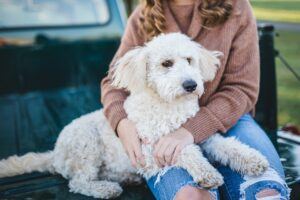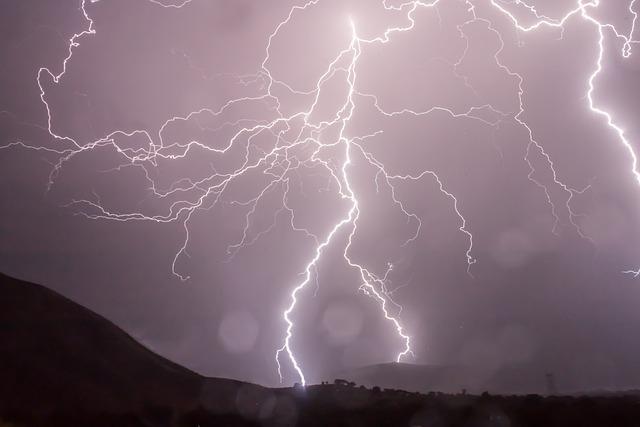I remember the first time my dog panicked during a thunderstorm. It startled me; I never imagined she could feel so  afraid. Your dog might react similarly, and it’s crucial to recognize these stress signals. Pacing, whining, hiding, or even destructive behavior can all indicate fear. These signs often go beyond the occasional flinch; they reveal a deeper anxiety that needs addressing.
afraid. Your dog might react similarly, and it’s crucial to recognize these stress signals. Pacing, whining, hiding, or even destructive behavior can all indicate fear. These signs often go beyond the occasional flinch; they reveal a deeper anxiety that needs addressing.
But why do dogs get scared? Several factors play a part. Thunder’s loud bangs are unfamiliar and unpredictable to dogs. Static electricity can also cause discomfort, prompting dogs to seek grounded spaces. Their heightened sense of hearing intensifies thunder’s impact, and past negative experiences can exacerbate the issue. It’s not a simple case of being ‘skittish.’ These fears can be deeply ingrained and require a sensitive approach.
Your dog’s wellbeing is at stake. Consistent fear can lead to chronic stress, which is not only heartbreaking to watch, it can harm their health over time. Vets are seeing more dogs with storm-related anxiety and emphasize the seriousness of managing it effectively.
Some common myths can cloud our understanding. For instance, the idea dogs will ‘just get over it’ is not only wrong, it’s harmful. Without proper help, storm phobia can worsen. Similarly, the belief that all dogs will grow out of this fear often leads to missed opportunities for early intervention.
With a clearer idea of what causes storm anxiety in dogs, it’s possible to create a calming environment for them. That’s critical for their comfort – and yours. What’s more, a safe space isn’t just about a physical location; it’s about establishing trust and security. This segues into the next discussion: crafting a sanctuary at home to alleviate your furry friend’s stress.
Creating a Safe and Comforting Space
When the sky rumbles and flashes, your dog might not see it as nature’s spectacle but rather as a threat. Your role is to create an environment that lessens this fear. It begins with establishing a safe space. Most dogs instinctively look for a sheltered area where they can hide from the perceived danger. Repurpose a closet or choose a cozy corner for your dog. Add their favorite toys and a comfortable bed to make it feel secure .
.
Soft, ambient sounds can help muffle the sharp cracks of thunder. Consider playing white noise or having a fan running. Some pets find classical music calming. Remember, your dog is sensitive to your emotions. If you’re anxious, they’re more likely to be as well. Stay calm, and your dog is more likely to feel secure.
The use of dog-appeasing pheromone diffusers can be beneficial. These mimic the calming pheromones a mother dog emits to reassure her pups. It’s a subtle yet effective way to help your dog relax. Additionally, think about the overall environment–dimming the lights can lessen the visual impact of lightning, and closing the windows can reduce the sounds and smells that might be distressing.
In the end, creating a comforting space is about being proactive. Anticipate your dog’s needs before the storm hits. By doing so, you not only mitigate their fear but also strengthen your bond, reassuring them that they are safe with you. It’s a thoughtful approach that can make a world of difference during the next thunderous outburst.
While creating a calming environment is crucial, it’s not a complete solution. Some dogs will require a more systematic approach to manage their fear. In the next section, we’ll examine training and desensitization techniques that you can integrate into your storm-preparation routine, adding another layer of reassurance for your anxious companion.
Training and Desensitization Techniques
If your dog quakes at the first rumble of thunder, know that training and desensitization can be powerful tools. These methods gently introduce your dog to what scares them, but in a controlled and mild way that doesn’t provoke the full-blown fearful response. This approach helps to change their emotional reaction over time. It’s like diffusing a ticking time bomb.
First, counter-conditioning is about creating positive associations. During a calm day, play a recording of thunderstorm sounds softly, pairing it with something your dog loves, like treats or a favorite game. Over weeks, gradually increase the volume, always ensuring your dog stays comfortable. Remember, it’s a marathon, not a sprint; rushing can set back progress.
Desensitization requires consistency. What you’re aiming for is to make thunderstorms normal, not notable. Consistent, gentle exposure over time reduces the likelihood of panic. Picture it as rehearsing a play until the lines are second nature, taking the sting out of the performance.
Sometimes, guidance from a professional dog trainer or a canine behaviorist may accelerate the process. These experts can tailor a program suited to your dog’s individual needs, spot subtle cues you may miss, and offer adjustments to your technique.
Sticking with these practices is essential. If training sessions become irregular, your dog’s fear might persist or even worsen. I remember working with a Dalmatian who overcame his phobia only after the owner committed to a consistent routine. It may require a significant time investment on your part, but the reward—witnessing your furry friend at ease during a thunderstorm—is immeasurable.
When to Seek Professional Help
I can’t emphasize enough how critical it is to recognize when your efforts at home need a boost from a professional. Sometimes, your canine friend may display signs that go beyond the usual anxiety, such as self-harm, destructive behavior, or an inability to recover long after a storm has passed. These are red flags that your dog’s phobia might require more than just a comfortable blanket and gentle reassurance.
Enlisting the help of a veterinarian or a certified animal behaviorist can open the door to a range of treatment options. From prescription medications that help to manage anxiety to specialized therapy techniques like systematic desensitization conducted by experts, your pet doesn’t have to suffer in silence.
Creating a tailored treatment plan for your dog is a collaborative effort. Your vet may recommend a combination of therapies, depending on the severity of your dog’s fears. It’s important that you feel empowered in this process, understanding each step and how it contributes to the well-being of your furry companion.
Finally, remember you’re not alone in this journey. Connecting with other pet owners who have faced similar challenges can provide comfort and practical tips. Their success stories serve as a beacon of hope that, with persistence and the right professional help, the turbulent times of thunderstorms can become more bearable for your treasured pet.


what an interesting article, I had no clue this was such an issue, how severe can static electricity get to the dogs, is it known if the effects are a sharper pain than it gives to humans?
are some breeds more susceptible than others? I would like to know if gun dogs and other hunting breeds suffer as bad?
I would have thought turning the lights down would have made the lightning show up even more?
With all the doggy aids I have seen on the market, I am surprised there is not a full range of noise-cancelling earphones for dogs, no there is a good idea
Thank you for your thoughtful comment! I’m glad you found the article interesting. Static electricity can indeed be a significant issue for dogs during thunderstorms. Dogs can be more sensitive to static electricity than humans, and the sensation can be quite uncomfortable for them. While it’s hard to measure the exact pain levels, it’s clear that dogs experience more distress due to their heightened sensitivity and acute hearing.
As for breed susceptibility, it seems that any dog can suffer from storm anxiety, but some breeds might be more prone due to their temperament and sensitivity. Gun dogs and hunting breeds, which are often more sensitive to their surroundings, can indeed suffer from storm anxiety. Their natural alertness and acute hearing can make thunderstorms particularly distressing for them.
Turning the lights down can indeed make the lightning more noticeable. However, for some dogs, reducing overall stimuli in their environment can still help them feel more secure. The goal is to create a calm, safe space where they feel protected from the storm.
Noise-cancelling earphones for dogs is an interesting idea! While there are many products on the market designed to calm dogs during storms, such as anxiety wraps and calming sprays, noise-canceling technology could certainly be a useful addition. Until such products are widely available, using white noise machines or calming music can help mask the sound of thunder.
Thank you again for your comment and for sharing your thoughts. If you have any other questions or need further advice, feel free to ask!
Kind regards Tim
Have you connected with other pet owners who have dogs with storm anxiety? What experiences or advice have been most helpful in managing your dog’s fear during thunderstorms?
Managing storm anxiety in dogs often requires long-term strategies. How do you maintain consistency in helping your dog cope with thunderstorms throughout different seasons or environments?
—
Thank you for your insightful comment!
Connecting with other pet owners who have dogs with storm anxiety has indeed been incredibly helpful. Through various online forums and local pet groups, I’ve learned about different experiences and strategies that have made a significant difference.
Some of the most helpful advice includes:
1. **Creating a Safe Space**: Many pet owners recommend setting up a cozy, quiet area where the dog feels secure. This might include a crate with blankets or a specific room where they can retreat during a storm.
2. **Desensitization Training**: Gradually exposing the dog to recordings of thunderstorms at a low volume and rewarding calm behavior has been a widely suggested method. Over time, this can help reduce the dog’s anxiety response.
3. **Calming Products**: Items such as anxiety wraps (like Thundershirts), calming collars, or pheromone diffusers have been beneficial for some dogs. These products can provide a sense of security and calm during storms.
Maintaining consistency in helping my dog cope with thunderstorms involves a few key practices:
1. **Routine**: Keeping a consistent daily routine helps my dog feel more secure overall, which can make them more resilient to sudden stressors like thunderstorms.
2. **Positive Reinforcement**: I consistently use positive reinforcement techniques to reward calm behavior. This helps reinforce the idea that staying calm during a storm is a good thing.
3. **Environmental Adaptations**: I make adjustments to ensure my dog feels safe depending on the season or environment. For instance, during the stormy season, I might keep the windows closed and use white noise machines to muffle the sound of thunder.
Connecting with a veterinarian or a professional dog trainer who specializes in anxiety can also provide personalized strategies that work best for your dog’s specific needs.
I hope these insights are helpful! Please share your experiences or additional tips that have worked for you and your furry friend.
Kind regards Tim
—